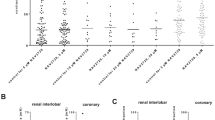Summary
Coronary dilation induced by infusion of adenosine, adenine nucleotides, dipyridamole, and papaverine was quantitated in the spontaneously beating isolated perfused guinea pig heart. Theophylline antagonized the effects of all the substances tested. The inhibition proved to be reversible and of a competitive type.
Single injections of ADP and ATP induced flow increases which were more rapid in onset and of greater magnitude than those due to equimolar amounts of adenosine. Lowering the perfusate temperature prolonged coronary responses to ADP and ATP more than those to adenosine.
Papaverine produced greater maximal dilation than adenosine. Theophylline inhibited papaverine-induced dilation less effectively than dilating responses to adenosine and other compounds. In the potassium arrested heart, the dilation caused by compound D 600 and papaverine was sensitive to the perfusate calcium concentration but that due to adenosine was unaffected. Dipyridamole, which was equipotent to adenosine in the non-arrested heart, became less potent than adenosine in the arrested heart.
The results favour the view that all of the substances tested induce coronary dilation per se and that their effects are not mediated by adenosine. The dilator response to papaverine is assumed to be the result of two effects, one of which is inhibited by theophylline, the other by high extracellular calcium.
Similar content being viewed by others
References
Afonso, S.: Inhibition of coronary vasodilating action of dipyridamole and adenosine by aminophylline in the dog. Circulat. Res.26, 743 (1970)
Baer, H. P., Drummond, G. J.: Catabolism of adenine nucleotides by the isolated perfused rat heart. Proc. Soc. exp. Biol. (N. Y.)127, 33 (1968)
Bittar, N., Pauly, T. J.: Myocardial reactive hyperemia responses in the dog after aminophylline and lidoflazine. Amer. J. Physiol.220, 812 (1971)
Bohr, D. F.: Vascular smooth muscle updated. Circulat. Res.32, 665 (1973)
Bünger, R., Haddy, F. J., Querengässer, A., Gerlach, E.: An isolated guinea pig heart preparation with in vivo like features. Pflügers Arch.353, 317 (1975)
Dietmann, K., Roesch, E., Schaumann, W., Juhran, W.: The effect of cyclic adenosine- and guanosine 3′,5′-monophosphate on the normal and drug-increased coronary blood flow. Biochem. Pharmacol.21, 2193 (1972)
Dixon, M.: The determination of enzyme inhibitor constants. Biochem. J.55, 170 (1953)
Fleckenstein, A.: Pathophysiologische Kausalfaktoren bei Myokardnekrose und Infarkt. Wien. Z. inn. Med.52, 133 (1971)
Fleckenstein, A., Grün, G.: Prinzipielles zur Wirkung von Ca++-Antagonisten auf die bioelektrische und mechanische Funktion glatter Muskelzellen. In: Vascular smooth muscle, p. 62. Berlin-Heidelberg-New York: Springer 1972
Gerlach, E., Deuticke, B., Dreisbach, R. H., Rosarius, C. W.: Zum Verhalten von Nucleotiden und ihren dephosphorylierten Abbauprodukten in der Niere bei Ischämie und kurzzeitiger postischämischer Wiederdurchblutung. Pflügers Arch. ges. Physiol.278, 296 (1963)
Hopkins, S. V.: The action of ATP in the guinea pig heart. Biochem. Pharmacol.22, 335 (1973)
Jacob, M. I., Berne, R. M.: Metabolism of purine derivatives by the isolated cat heart. Amer. J. Physiol.198, 322 (1960)
Kohlhardt, M., Bauer, B., Krause, H., Fleckenstein, A.: Differentiation of transmembrane Na and Ca channels in mammalian cardiac fibres by the use of specific inhibitors. Pflügers Arch.335, 309 (1972)
Richterich, R.: Klinische Chemie, Theorie und Praxis. Basel: S. Karger 1971
Schaumann, W., Juhran, W., Dietmann, K.: Antagonismus der Kreislaufwirkungen von Adenosin durch Theophyllin. Arzneimittel-Forsch.20, 372 (1970)
Scholtholt, J., Nitz, R. E., Schraven, E.: On the mechanism of the antagonisti action of xanthine derivatives against adenosine and coronary vasodilators. Arzneimittel-Forsch.22, 1255 (1972)
Scott, J. B., Daugherty, R. M., Jr., Dabney, J. M., Haddy, F. J.: Role of chemical factors in regulation of flow through kidney, hind-limb, and heart. Amer. J. Physiol.208, 813 (1965)
Spieckermann, P. G., Hellberg, K., Kettler, D., Reploh, H. D., Strauer, B.: Hemmung der coronardilatierenden Wirkung von Adenosin, Dipyridamol, Hexobendin und ASTA C 4898 durch Aminophyllin (Theophyllin-Äthylendiamin). Pflügers Arch.312, R 15 (1969)
Author information
Authors and Affiliations
Rights and permissions
About this article
Cite this article
Bünger, R., Haddy, F.J. & Gerlach, E. Coronary responses to dilating substances and competitive inhibition by theophylline in the isolated perfused guinea pig heart. Pflugers Arch. 358, 213–224 (1975). https://doi.org/10.1007/BF00587218
Received:
Issue Date:
DOI: https://doi.org/10.1007/BF00587218



